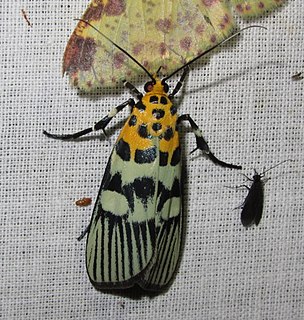Related Research Articles

The Crambidae are the grass moth family of lepidopterans. They are variable in appearance, the nominal subfamily Crambinae taking up closely folded postures on grass stems where they are inconspicuous, while other subfamilies include brightly coloured and patterned insects which rest in wing-spread attitudes.

The Pyralidae, commonly called pyralid moths, snout moths or grass moths, are a family of Lepidoptera in the ditrysian superfamily Pyraloidea. In many classifications, the grass moths (Crambidae) are included in the Pyralidae as a subfamily, making the combined group one of the largest families in the Lepidoptera. The latest review by Eugene G. Munroe and Maria Alma Solis, in Kristensen (1999) retains the Crambidae as a full family of Pyraloidea.

The Pyraloidea are a moth superfamily containing about 16,000 described species worldwide, and probably at least as many more remain to be described. They are generally fairly small moths, and as such, they have been traditionally associated with the paraphyletic Microlepidoptera.
The Tineodidae or false plume moths are a family of moths with in some cases unusually modified wings: Like in some related moths, the wings of several Tineodidae are decomposed into several rigid spines. This is a small family, with about a global total of 20 species described to date; some undescribed species are known or suspected to exist however. They seem to be of Australian origin, where they are most diverse, but range through the Wallacea to Southeast and South Asia, and into the Pacific to the Marquesas Islands.

Ostrinia is a genus of moths in the family Crambidae described by Jacob Hübner in 1825. Several of them, including the European corn borer, are agricultural pests.

Cryptoblabes gnidiella, the honeydew moth or Christmasberry moth, is a moth of the family Pyralidae. It is natively found around the Mediterranean Sea and is an introduced species in South America and Middle America.
In biological taxonomy, circumscription is the content of a taxon, that is, the delimitation of which subordinate taxa are parts of that taxon. If we determine that species X, Y, and Z belong in Genus A, and species T, U, V, and W belong in Genus B, those are our circumscriptions of those two genera. Another systematist might determine that T, U, V, W, X, Y, and Z all belong in genus A. Agreement on circumscriptions is not governed by the Codes of Zoological or Botanical Nomenclature, and much be reached by scientific consensus.

Calamotropha is a genus of moths of the family Crambidae.

Palpita is a genus of moths of the family Crambidae. Members of the moth genus Stemorrhages may be very similar in appearance.

Scoparia pyralella, the meadow grey, is a species of moth of the family Crambidae. It was first described by Michael Denis and Ignaz Schiffermüller in 1775.

The Galleriinae are a subfamily of snout moths and occur essentially worldwide, in some cases aided by involuntary introduction by humans. This subfamily includes the wax moths, whose caterpillars (waxworms) are bred on a commercial scale as food for pets and as fishing bait; in the wild, these and other species of Galleriinae may also be harmful to humans as pests.

Tirathaba rufivena, the coconut spike moth, greater coconut spike moth or oil palm bunch moth, is a moth of the family Pyralidae. It is found from south-east Asia to the Pacific islands, including Malaysia, the Cook Islands, the Philippines and the tropical region of Queensland, Australia. They are considered as a minor pest.

The Phycitini are a tribe of moths of the family Pyralidae.
The Anerastiini are a tribe of moths of the family Pyralidae.
Navasota is a genus of snout moths described by Émile Louis Ragonot in 1887.
Navasota discipunctella is a species of snout moth in the genus Navasota. It was described by George Hampson in 1918 and is known from Nigeria.

Orocrambus cyclopicus is a moth in the family Crambidae. It was described by Edward Meyrick in 1883. In 1975 David E. Gaskin wrongly synonomised Crambus sophistes with Orocrambus cyclopicus.
Eugene Gordon Munroe was a Canadian entomologist who discovered numerous species of insects. He worked for the Insect Systematics and Biological Control Unit, Entomology Division in Ottawa, Canada.
Tinerastia fissirella is a moth of the family Pyralidae.

Vitessa suradeva is a moth of the family Pyralidae. It is found in India, Bangladesh, Myanmar, Thailand, Vietnam and Sri Lanka.
References
- ↑ "An inventory of Indian pyralids (Lepidoptera: Pyralidae)". Research Gate. Retrieved 2 March 2018.
- ↑ "Species Details : Tinerastia discipunctella Hampson, 1896". Catalogue of Life. Retrieved 2 March 2018.